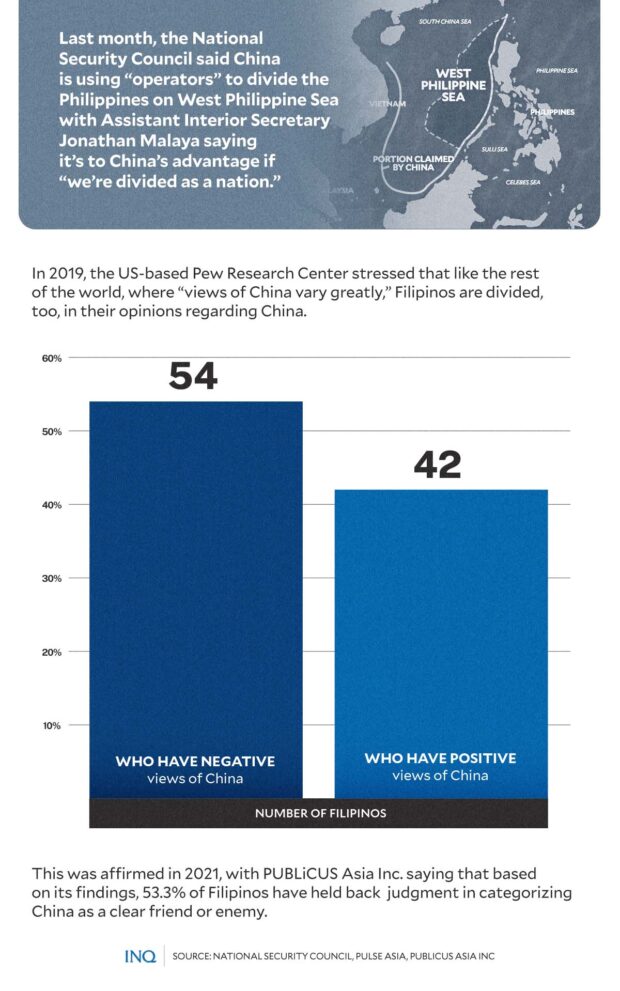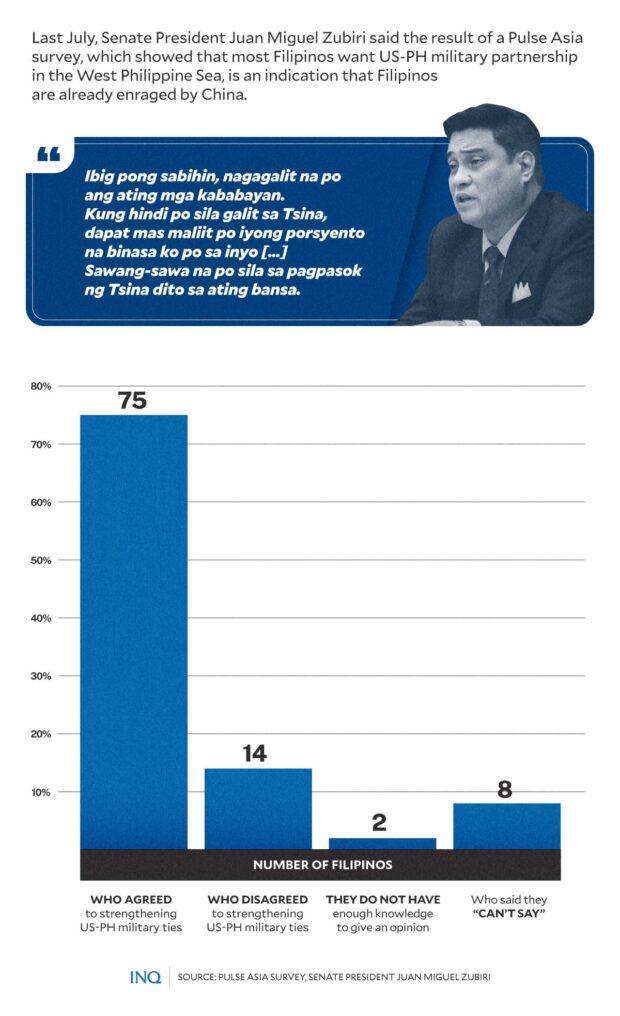FIRST OF TWO PARTS
MANILA, Philippines — China’s divide-and-rule tactic, according to a security expert, heeds a classic military strategy that “sustains the dogmatic view that it’s better to conquer territories that are not shattered by the ruins of war.”
Dr. Chester Cabalza, president and founder of the International Development and Security Cooperation (IDSC), said this as the National Security Council (NSC) made public intelligence about China “operators” trying to divide Filipinos on Philippine sovereignty in the West Philippine Sea (WPS).
Last month, NSC spokesperson Jonathan Malaya said in an interview with AM radio station dzBB that China was engaged in “psychological or cognitive warfare” to prevent Filipinos from uniting against Chinese intrusion in WPS, which is part of the Philippine exclusive economic zone (EEZ).
“It is to their advantage that we’re divided as a nation,” Malaya said.
According to Cabalza, a divided Philippines works to China’s advantage even without war.
“The goal of Beijing is to disrupt the region through cognitive dissonance, disinformation, and gray zone strategy,” said Cabalza.
“By doing this, China wants the region to decouple ASEAN from too much dependence on the US and its Western allies,” he added.
“Once the region becomes polarized, countries will derisk and hedge with the two economic superpowers. Since China is a resident power in the Indo-Pacific region, it would be easy for them to compete with the US and contain their rivals.”
The divide-and-rule tactic, he said, has been “wisely tested by successful empires, dynasties and regimes.”

MIXED VIEWS | The NSC said China is using “operators” to divide the Philippines on the West Philippine Sea. (Graphic by ED LUSTAN / INQUIRER.net)
“It propagates new norms of political ‘cancel culture’ and economic sabotage using its seasoned wolf warrior diplomats and operators,” Cabalza said.
Cabalza, a security and defense analyst, told INQUIRER.net via FB Messenger that it is more strategic and cost-efficient to use “hostile antagonism and aggression than waging an actual shooting war.”
Last July, Senate President Juan Miguel Zubiri said a clear sign of a united stand against Chinese aggression in WPS was a survey result showing that 75 percent of Filipinos support a stronger military partnership between the United States and the Philippines.
The survey, by Pulse Asia, showed that only 14 percent of Filipinos opposed stronger Philippine-US defense ties.
“Filipinos are already sick and tired, especially of China’s incursions,” said Zubiri. He said if there was no unity against China, “the percentage I read should have been lower.”

YES TO ALLIANCE. Senate President Juan Miguel Zubiri said Filipinos’ positive view on stronger PH-US relationship is an indication that Filipinos are already enraged by China. (Graphic by ED LUSTAN / INQUIRER.net)
Looking back, Social Weather Stations (SWS) stated in 2019 that most Filipinos, or 87 percent, want the government to assert its rights over WPS to follow through the Philippines’ win against China in 2016 at the Permanent Court of Arbitration (PCA).
PCA ruled in 2016 that the Philippines has exclusive sovereign rights over WPS, which is inside Philippine EEZ but which China, thousands of kilometers away, is claiming to own.
But some Filipinos, including government officials, have refused to brand China as clear enemy or friend with 53.3 percent saying China could be either, according to a report by Publicus Asia.
READ:Makabayan wants July 12 declared as West Philippine Sea Day
READ:Senate votes for revised resolution on West PH Sea
This seemed like a reiteration of what the US-based Pew Research Center said in 2019—that like the rest of the world, where “views of China vary greatly,” Filipinos are divided, too, in their opinion of China, with 54 percent and 42 percent having negative and positive views.
Joshua Bernard Espeña, a resident fellow of IDSC and lecturer at the Polytechnic University of the Philippines, stressed that in the use of divide and rule, China’s operators “try to argue that a bloodless hand is better than a bleeding hand.”
“This is a universal playbook for defeating the enemy and acquiring territory (and controlling sea lanes),” he told INQUIRER.net via FB Messenger, pointing out that “a lack of strategic thinking may put the country at peril in terms of accepting defeat.”
As Malaya stressed, the hazy claim of China that a promise was made by the Philippine government to remove the BRP Sierra Madre from Ayungin Shoal in WPS was Beijing’s way “to divide us” and make Filipinos “point fingers” instead of unite.
“Let us not fall into the[ir] trap,” he said.
President Ferdinand Marcos Jr. already said the government did not promise China to remove the BRP Sierra Madre, a warship intentionally grounded to serve as an outpost for the Philippines in WPS.
Espeña, a defense analyst, said China’s “strategy is to simply divide narratives of the opposing side and negate the enemy’s will to fight in due time.”
Cabalza pointed out that China’s divide and rule tactic in Southeast Asia which, he described as the “theater of current strategic power competition between the US and China” started when China reclaimed and militarized the South China Sea.
“The blueprint of the divide and rule plan in ASEAN was pushed by the U-shaped map with various versions of dashes using the debunked historical claims won by the Philippines in the Unclos (United Nations Convention on the Law of the Sea) in 2016,” he said.
As the PCA ruling said, the nine-dash line was first inscribed on a map when China’s Ministry of the Interior published a “Map Showing the Location of the Various Islands in the South China Sea.” The PCA said the map had no legal basis.
READ: Aggression in West PH Sea: China’s maritime ‘Great Wall’ plan
But this year, China released its latest standard map, with one new dash in the eastern section of Taiwan. The Spratly Islands, which included the Kalayaan Island Group, where more than 400 Filipinos live specifically in Pag-asa Island, are covered by the dashes.
It was pointed out by Cabalza that “for sure, it’s part of its cognitive warfare strategy to condition the minds of the Chinese that Taiwan and the entirety of the South China Sea belong to them.”
Espeña said “maps are not just for scientific purposes but also for political,” since “they convey imagination” that must be constantly played in the minds of the people: “Maps are powerful tools that ‘operators’ can also play into the fore,” he said.
War philosophers Sun Tzu and Carl von Clausewitz are “helpful strategic thinkers” for the divide and rule strategy.
Paraphrasing Sun Tzu, Espeña said: “The best way to defeat enemies is deceit and indirect approaches: You use information tactics such as these operators to win without fighting Filipinos and their allies in a battle.”
Turning to Clausewitz, meanwhile, he said: “War is about subduing the enemy to do your will.” which means that “war has a psychological dimension; you have to persuade your enemies that what they are fighting for could either be a lost cause or costly to fight for.”
Espeña, an international affairs academic, pointed out that “China understands that while we have been reliant on the US for external defense, we also have a long quest for a genuinely independent foreign policy. As China operators argue, an ‘independent’ decision is not to fight Beijing over ‘tiny features of the sea’ but peacefully settle for less since they have the upper hand to create harmonious relations in the region.”
Espeña said “in contemporary times, we can see this operating in the business environment,” stressing that “needless to say, the country’s relatively corrupt atmosphere to doing business makes it susceptible to entering shady deals.”
“This shapes the business community’s minds about China. It ripples through the private-public partnership where political families either have ties or are part of the business circles,” said Espeña.
He said: “We may find politicians and big stakeholders such as business leaders not in the mood for upping defense capabilities against foreign adversities who may already have the upper hand in working within the society.”
As explained by Cabalza, the second effective mechanism of China’s bid to divide the region was the Belt and Road Initiative launched in 2013. Many ASEAN members that also have claims in the South China Sea received funds from China in what is now being described as economic warfare.
“Aggressive trade ties of Beijing to Southeast Asian capitals saw favoritism from China’s economic diplomacy in dealing with countries that favor Chinese interests in the region,” Cabalza said.
“Nations that contradict their bold actions in the South China Sea are punished in terms of unfulfilled economic pledges or sanctions on agricultural preferential treatment on exports,” he said.
“China has been pushing for three warfare strateg[ies] as a trojan horse using political, economic, and informational dimensions of their strategic successes in the region,” Cabalza added.
As Espeña said the operators serve as financiers of information drive in the cyber domain, too, where the public spends most of the time scrolling on social media: “In this case, operators may be successful in feeding their narrative based on a state with a relatively weak development model.”
But this is not the only thing to blame.
“The divisions thrive because of the lack of unified narrative before and our missed opportunity to leverage with China when we tried to pivot with them,” Cabalza said.
“Beijing can trick our national leaders using cognitive and psychological warfare to meet their ends,” he added.
“The lack of national security consciousness of local government leaders was also exploited by China utilizing their widened economic clout to lure local governments with tangible economic outputs needed by their constituents,” Cabalza added.
READ: Tensions in West Philippine Sea not ‘cooling down’ – Marcos
For Espeña, the past administration, led by Rodrigo Duterte, stepped in and personified that long quest for Filipino strategic culture — to peacefully settle for less.
“You would find the former President himself telling his audience that nothing more in his desire is to find the Philippines in a position where nobody would die,” Espeña said.
“But clearly, this mindset fails against the metric of the core foreign policy interest of the Philippines,” he said.
Espeña pointed out that the Philippines should continue to fight for its rights, even when costly, and even if unity is made to appear elusive.
“I argue this based on two fallacies that China committed,” he said.
“The more operators become aggressive, the more they are tracked. But this is just the classic behavior of rising great powers—they want to be heard on the world stage,” he said.
“If we follow Sun Tzu’s logic closely — that it uses other means to avoid fighting, we must cap on pushing China into conflict,” said Espeña.
“It knows that it cannot handle the implications of fighting the Philippines now that the latter is supported by its allies and partners due to the 2016 arbitral award,” he said.
He pointed out that “Manila must play the classic playbook: If we want peace, prepare for war. Only for us to resist what the ‘operators’ say!”
Cabalza said it was not enough for the Philippines to counter Chinese strategy through collective deterrence with allies, military modernization, unity under the PCA ruling, and transparency in WPS.
“The Philippines has to be clever in the complexity of our bilateral relations with China,” Cabalza said.

An illustration of the 10-dash line map, which China released in August. GRAPHIC BY ED LUSTAN
READ:‘We’re not backing down’: PH message to China is now louder
READ:Coast Guard tells Senate China might be sowing fake news on WPS row
“The Philippines should have an uncompromising attitude towards the preservation of our national sovereignty and territorial integrity against China’s use of water canons and military laser grade, and upgrading its map to 10-dash line, to intimidate our cause to save our maritime and territorial claims,” he said.